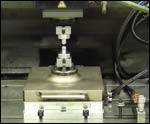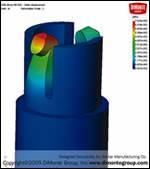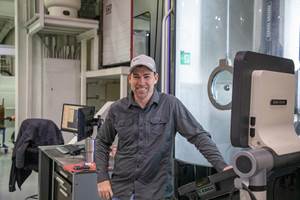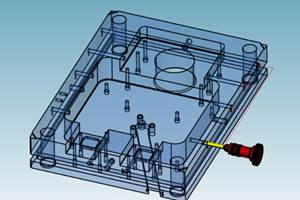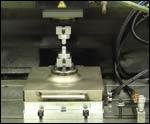ASH Industries Relies on CAE Services for Production Advances
CAE simulations and Mold-Vac units help bolster quality and customer satisfaction.
Founded in 1991, ASH Industries (Lafayette, LA) specializes in part engineering for manufacturability, mold manufacture, thermoplastic injection molding, component integration into assemblies, DOE, IQ/OQ/PQ, cleanroom assembly, ultra-sonic welding, epoxy bonding, pad printing, hot stamping, custom packaging, and drop shipping. Its operations include the implementation of JIT and TOC programs to limit inventories for production runs of ten million assemblies to one thousand custom parts. ASH Industries’ equipment ranges from 20 to 700 ton capacity and is capable of producing parts from 0.1 gram to 2,500 grams.
Steve Andrepont is ASH Industries’ Engineering Manager. He says he and his colleagues are engineers addressing the needs of engineers. “Our customers know their applications and desired outcomes while we understand manufacturability and processing capability.”
Recently, ASH Industries contacted CAE Services (Batavia, IL) to perform Moldflow analysis to confirm and apply mold and process adjustments on a plastic part. The analyses were performed to predict potential processing challenges. As a result of the work, CAE’s analysis shortened the cycle time of the project and eliminated wasted resources. “We did not have to go back into the tool to adjust runner or gate sizes. More important was that we did not have to adjust gate locations, which is quite costly,” says Andrepont.
“Prior to conducting the analysis,” notes Andrepont, “we knew the process window would be very tight, room for adjustment non-existent, and our customer was intolerant of variability. We needed predictable molding results very quickly. We expected to have a window into the process that reflected our experience and warned us of aspects we had not considered. CAE Services offered us insight not found by any other means.” He also notes that the part had many windows resulting in trapped air and knit lines. By adjusting gate locations and evacuating the air in the cavity with Mold-Vac, the part fills without any visible knit lines.
He says that the Moldflow simulations did an excellent job of predicting reality. The gate and runner size modeled in Moldflow yielded true mold fill times and was very close on pressure. It gave accurate locations for venting the cavities, as well. “The results were so good that we used the CAE as a benchmark of what the process should be,” Andrepont adds.
Moldflow Dominance
Moldflow software is a leading product for in-depth simulations to validate part and mold design. Its unique, patented Dual Domain technology allows users to analyze CAD solid models of thin-walled parts—facilitating less model preparation time. The visualization and project management tools help users undertake extensive design analysis and optimization. When analyses are complete, users can produce detailed, Web-ready design reports for extensive review throughout an organization and to customers.
Moldflow’s analysis products can simulate plastics flow and packing, mold cooling, and part shrinkage and warpage for thermoplastic injection molding, gas-assisted injection molding, co-injection molding and injection-compression molding processes. Additional modules simulate reactive molding processes including thermoset and rubber injection molding, reaction injection molding (RIM), structural reaction injection molding (SRIM), resin transfer molding, microchip encapsulation and Underfill (flip-chip) encapsulation.
The costs associated with the analysis results were justified in time-line compression alone. Andrepont explains that when mold modifications and trial and error methodologies that would have been necessary without the analyses were considered, the analysis was a small price to pay. While quantifiable figures were not measured, he says that the CAE analysis did eliminate the typically expected difficult aspects of the project.
CAE Savvy
Andrepont and his staff are CAE advocates. They say other manufacturers that face tough engineering and processing challenges while trying to reduce leadtimes, costs and scrap rates should strongly consider using CAE simulations. “If you anticipate a tight processing window—either because of material choice, mold configuration, or intolerance in typical part variability—CAE mold analysis will fortify your project with knowledge and eliminate costly and delayed-filled guesswork. I would not be tolerant of a result that did not conform with our experience. CAE will help narrow process window expectations,” Andrepont notes.
Mold-Vac on the Shop Floor
In addition to relying on CAE Services for Moldflow analysis, ASH Industries purchased a Mold-Vac unit from CAE Services. Prior to implementing the Mold-Vac 4000 unit, ASH Industries was tasked with manufacturing a part of typical material in a typical mold configuration. The demands of the product function; however, were completely intolerant of variation from cycle to cycle. The parts have very thin lens features that were unsuccessfully molded in previous tooling attempts. Mold-Vac made this feature possible. Andrepont says his team needed to eliminate as much variability as possible.
Mold-Vac units eliminate problems caused as a direct result of gas and air entrapment. Exclusive to Mold-Vac is its blowback control that cleans vented pins after every cycle. Mold-Vac provides precise microprocessor control for both vacuum and blowback timing functions. The units are easy to install and operate. They eliminate or reduce problems with part burns, voids, short shots, mold maintenance, downtime, flashing and tool steel erosion. CAE Services assists molders in determining which Mold-Vac system is best suited for each application. Proper selection is based upon part volume, fill time, mold design, material and other variables. Mold-Vac units can be used for thermoplastic and thermoset materials.
As a result of installing the Mold-Vac machine, ASH Industries has narrowed its processing window to an extreme. Its customer is quite satisfied with the parts produced via Mold-Vac assistance, and ASH Industries is strongly considering purchasing more Mold-Vac units for many other areas at its facility.
Summary
ASH Industries’ relationship with CAE Services has generated many benefits as a result of CAE’s Moldflow expertise and recommendations based on the software simulation results. In addition, Andrepont says ASH Industries has been able to accelerate production and eliminate downtime on the shop floor as a direct result of installing the Mold-Vac system.
Related Content
Laser Welder Yields Fast, Precise Mold Repair
Intralox's integration of the Alpha Laser ALFlak has significantly improved their tool room efficiency when it comes to difficult welds and urgent repairs.
Read MoreSpeed, Productivity Gains and High Uptime Ease Decision for Second Five-Axis Machine
Byrne Tool + Design reduced setups and gained speed and productivity thanks to fast, accurate and compact five-axis CNC machining centers.
Read MoreHow to Clean and Maintain Molds With Intricate Conformal Cooling Channels
A water-based, eco-friendly plastic mold cleaning system helps Rankine-Hinman Manufacturing restore flow rates and avoid big-ticket failures on complex and costly molds.
Read MoreCAM Automation Increases Mold Production, Quality
Mold builder switches CAM software package after 20 years to take advantage of innovative programming strategies that reduce mold machining programming and processing times.
Read MoreRead Next
Team Approach Is Key to Proper Inspection
Using a group rather than one person and changing the order of inspection is a win-win for this moldmaker—repeatable results with no rework.
Read MoreBreaking the Mold in Mold Development
Integrated analysis capabilities streamline mold design.
Read MoreDoes Your CAD System Support Design and Validation In One Window?
Implementing one tool that can handle part design, mold design, part structural analysis and mold filling analysis is becoming a necessity for today’s mold shops.
Read More
